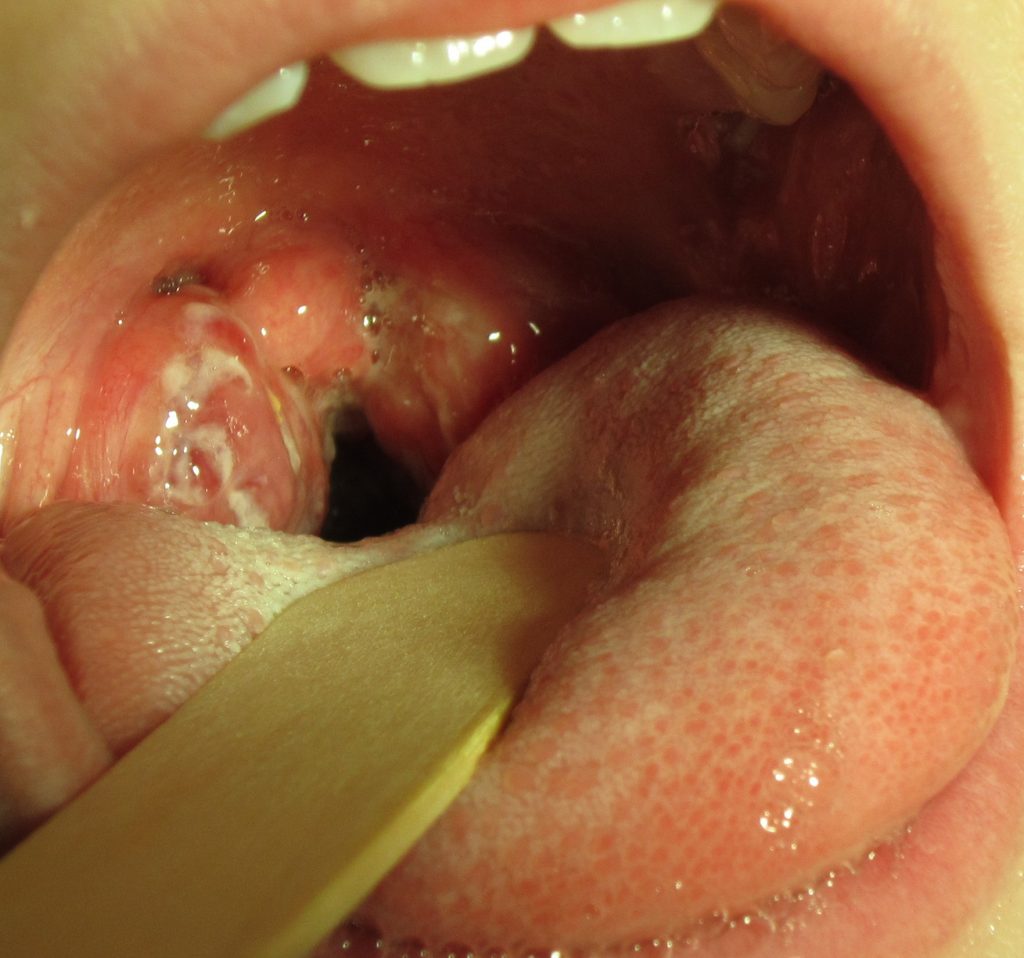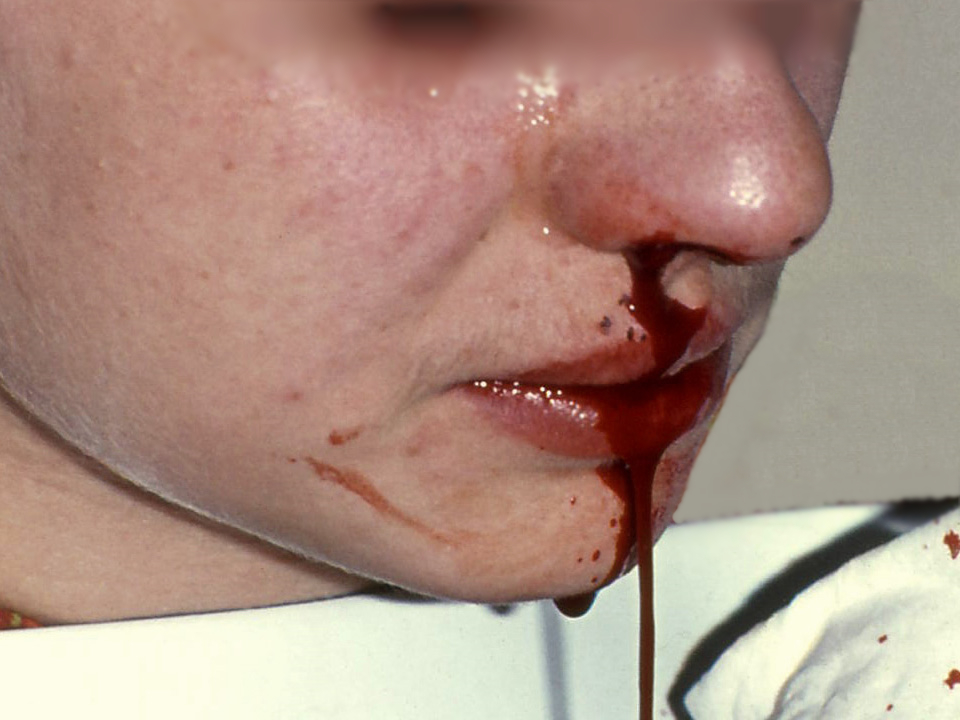6.11 Other Disorders of Head and Neck
Sinusitis
Sinusitis is the medical diagnosis for inflamed sinuses that can be caused by a viral or bacterial infection. When the nasal membranes become swollen, the drainage of mucous is blocked and causes pain.
There are several types of sinusitis, including these types:
- Acute Sinusitis: Infection lasting up to 4 weeks
- Chronic Sinusitis: Infection lasting more than 12 weeks
- Recurrent Sinusitis: Several episodes of sinusitis within a year
Symptoms of sinusitis can include fever, weakness, fatigue, cough, and congestion. There may also be mucus drainage in the back of the throat, called postnasal drip. Health care providers diagnose sinusitis based on symptoms and an examination of the nose and face. Treatments include antibiotics, decongestants, and pain relievers.[1]
Pharyngitis
Pharyngitis is the medical term used for infection and/or inflammation in the back of the throat (pharynx). Common causes of pharyngitis are the cold viruses, influenza, strep throat caused by group A streptococcus, and mononucleosis. Strep throat typically causes white patches on the tonsils with a fever and enlarged lymph nodes. It must be treated with antibiotics to prevent potential complications in the heart and kidneys. See Figure 6.27[2] for an image of strep throat in a child.

If not diagnosed as strep throat, most cases of pharyngitis are caused by viruses, and the treatment is aimed at managing the symptoms. Nurses can teach clients the following ways to decrease the discomfort of a sore throat:
- Drink soothing liquids such as lemon tea with honey or ice water.
- Gargle several times a day with warm salt water made of 1/2 tsp. of salt in 1 cup of water.
- Suck on hard candies or throat lozenges.
- Use a cool-mist vaporizer or humidifier to moisten the air.
- Try over-the-counter pain medicines, such as acetaminophen.[3]
Tonsillitis
Tonsillitis is a common condition particularly in children that involves inflammation of the tonsils, which are two oval-shaped pads of tissue at the back of the throat. It is often caused by viral or bacterial infections, with the most frequent culprits being the Streptococcus bacteria. The inflammation can lead to symptoms such as sore throat, difficulty swallowing, fever, swollen lymph nodes, and sometimes a distinctive white or yellow coating on the tonsils. In severe cases, individuals may experience difficulty breathing due to swollen tonsils obstructing the airway.
Interventions for tonsillitis typically depend on the underlying cause. Viral tonsillitis often resolves on its own with rest, hydration, and over-the-counter pain relievers to manage symptoms. Bacterial tonsillitis, particularly when caused by Streptococcus, may require antibiotic treatment to prevent complications such as rheumatic fever. In recurrent or severe cases, surgical removal of the tonsils, known as a tonsillectomy, may be recommended to alleviate symptoms and prevent future occurrences. Regular gargling with warm salt water and maintaining good oral hygiene can also help soothe symptoms and prevent infection spread.[4]
Epistaxis
Epistaxis, the medical term for a nosebleed, is a common problem affecting up to 60 million Americans each year. Although most cases of epistaxis are minor and manageable with conservative measures, severe cases can become life-threatening if the bleeding cannot be stopped.[5] See Figure 6.28[6] for an image of a severe case of epistaxis.

The most common cause of epistaxis is dry nasal membranes in winter months due to low temperatures and low humidity. Other common causes are picking inside the nose with fingers, trauma, anatomical deformity, high blood pressure, and clotting disorders. Medications associated with epistaxis are aspirin, clopidogrel, nonsteroidal anti-inflammatory drugs, and anticoagulants.[7]
To treat a nosebleed, have the victim lean forward at the waist and pinch the lateral sides of the nose with the thumb and index finger for up to 15 minutes while breathing through the mouth.[8] Continued bleeding despite this intervention requires urgent medical intervention such as nasal packing.
- MedlinePlus [Internet]. (2020). Sinusitis. https://medlineplus.gov/sinusitis.html ↵
- “Strep throat2010.JPG” by James Heilman, MD is licensed under CC BY-SA 3.0 ↵
- Centers for Disease Control and Prevention. (n.d.). Disparities in oral health. https://www.cdc.gov/oral-health/health-equity/ ↵
- Anderson, J., & Paterek, E. (2023). Tonsillitis. StatPearls [Internet]. https://www.ncbi.nlm.nih.gov/books/NBK544342/ ↵
- Fatakia, A., Winters, R., & Amedee, R. G. (2010). Epistaxis: A common problem. The Ochsner Journal, 10(3), 176–178. https://www.ncbi.nlm.nih.gov/pmc/articles/PMC3096213/ ↵
- “Epstaxis1.jpg” by Welleschik is licensed under CC BY-SA 3.0 ↵
- Fatakia, A., Winters, R., & Amedee, R. G. (2010). Epistaxis: A common problem. The Ochsner Journal, 10(3), 176–178. https://www.ncbi.nlm.nih.gov/pmc/articles/PMC3096213/ ↵
- American Heart Association. (2000). Part 5: New guidelines for first aid. Circulation, 102(supplement 1). https://www.ahajournals.org/doi/10.1161/circ.102.suppl_1.I-77 ↵
Inflammation of the sinus passages.
Inflammation of the pharynx.
A common condition particularly in children, involves inflammation of the tonsils, which are two oval-shaped pads of tissue at the back of the throat.
Rapid flow of blood from the nose, also known as rhinorrhagia.

